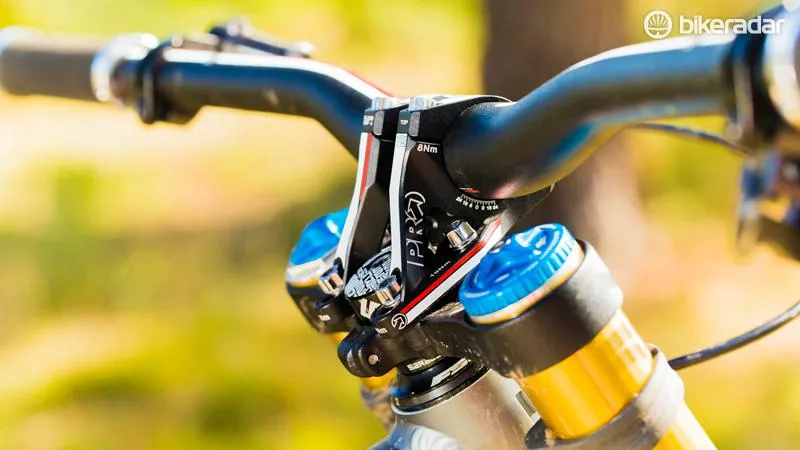Welsh downhill racer Manon Carpenter has had a fantastic season, winning three rounds of the World Cup to take the overall series prize and then blitzing the World Championships at Hafjell, Norway to add another two sets of rainbow stripes to the pair she won as a junior only three years ago.
She did it on a Saracen Myst that’s almost identical to the Team model here, so what does it take to be among the fastest in the world?
- Highs: Genuine World Championship speed, particularly on bigger hitting courses.
- Lows: It’s a proper punchy race bike, not a soft downhill dawdler.
- Buy If: You want a proper race-ready DH bike at a really good price.
Frame and equipment: ready to race
In terms of the World Cup paddock, Saracen is a very small, grass roots player with a limited budget so it’s no surprise that the Myst has been around in the same basic format for a few years. That doesn’t mean designer Simon Wild and his team aren’t innovators though, following extensive testing 2014 saw Saracen commit to the 650b wheels that it had already been among the first to introduce on its trail bikes.
While a lot of downhill brands seem to have struggled to find good geometry and rider position when switching to the slightly larger wheels, Saracen has got the shape spot on. The reworked, hydroformed seat tube is kinked to keep the carbon fibre back end short despite 203mm of rear wheel travel.
Related reading: Pro bike: Manon Carpenter's Saracen Myst Team issue - video
The three lengths of top tube are best described as long, really long and bloody miles away so you’ve no worries about tripping over the front however hard you’re corkscrewing into a corner under braking.
While Manon cuts her Pro bars down to 750mm the production bike gives you the full 800mm leverage to play with or prune. The toilet roll diameter Fox 40 fork legs add a whole new meaning to steering accuracy too. Add a full set of Shimano’s bombproof, mega-braked Saint DH componentry and you’re looking at a relative bargain in the often mega bucks world of gravity gear.

You don’t get Manon Carpenter’s race prepped RAD shock, but the standard DHX RC4 has been the benchmark DH damper for years
There are some things that money can’t buy though, and they include the Fox-sponsored racer-only RAD versions of the fork and rear shock. The stock 40 fork and DHX RC4 are noticeably stiffer over small bumps than RAD gear we’ve ridden, but there’s still a lot of compression damping and end stroke adjustment to play with.
Ride and handling: speed over comfort
Within metres you’ll realise this is definitely a bike designed to deliver raw race speed, not for carrying you comfortably down the hill. The taut shock tune and multi-piece linkage mean suspension movement is totally efficient and economical. There’s no wallow, over travel or mid stroke vagueness so you can stab pedal jabs into any space on the descent without affecting suspension composure.
The rock solid low speed compression feel and massive 37mm pivot bearings also connect your palms and feet directly to the thick-walled, chewing gum compound Continental Kaiser tyres for pin sharp feedback too.
You’ll need all that feedback and precision too, because the super-slack angles only stop stumbling about and the suspension only begins to absorb hits rather than abuse lack of commitment once you hit true go-big-or-go-home speeds.

Full Saint kit includes close ratio rear cassette and short cage mech, super strong hollow arm cranks and the most powerful brakes and advanced head eating pads and rotors in mountain biking
That means you’re left to suck up the small stuff yourself and it’s unforgivingly physical if you’ve only ridden a soft tuned long travel trail limo before not a proper race weapon.
In fact it’s such a physical bike that, like many other pro DH riders, Manon actually uses deliberately de-tensioned wheels to introduce some shock shrugging compliance on her race bike.
Another sign that while the geometry, travel, cockpit dimensions and suspension complexity of trail bikes is getting increasingly close to full-on downhill machines, stopping the clock first at a World Cup is still a lot different from playing on your favourite local Strava segment.
This article was originally published in What Mountain Bike magazine, available on Apple Newsstand and Zinio.





